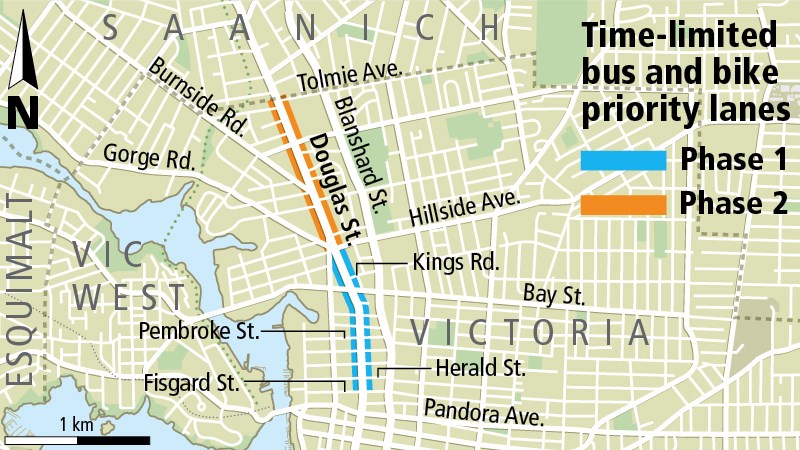B.C. Transit’s Douglas Street priority bus lanes are firing happily on all cylinders two months after beginning operation.
“We are really pleased,” said John Barry, communications manager for B.C. Transit.
“Usually these things take quite a bit of time for people to get used to the change in driving patterns and all the new symbols and the new signs.”
So far, he said, “we haven’t had any negative feedback.”
The transit-priority lanes, which are marked with signs and painted diamond symbols on the roadway, are designed to improve the reliability of buses and shorten travel times for bus riders.
They are reserved for buses and cyclists during rush hour — Monday to Friday 6 to 9 a.m. southbound, and 3 to 6 p.m. northbound. During those hours, motorists are allowed in the lanes only to make right-hand turns, and are not allowed to stop or park.
The one-kilometre stretch of lanes between Fisgard Street and Hillside Avenue opened on June 9, with another segement planned for next year.
At the time, Victoria Mayor Dean Fortin called it “an important first step” and noted that it was the first time the city had put people ahead of vehicles when making upgrades to transportation.
Redesigning and reconstructing the street cost about $1.5 million and was paid for by B.C. Transit and the Greater Victoria Transit Commission. A number of sidewalk bulbs — curb extensions often found at crosswalks — and about 80 parking spaces were removed.
Barry said a few issues arose during the initial week, mostly with motorists getting used to the loss of parking.
But B.C. Transit supervisors were out to make sure people were informed about what was happening.
Since then, nobody has voiced any issues about enforcement, he said.
Victoria police and city hall, likewise, both report no issues with enforcing the bus-priority lanes.
Barry said B.C. Transit’s bus drivers have quickly adapted to the priority bus lanes and have had nothing but positive feedback.
“The drivers have been really pleased,” he said.
Some concerns were voiced initially about cyclists sharing the lanes, but no issues have arisen so far.
“That’s something the [bus] drivers have to do routinely anyway,” Barry said. “They are all trained to watch out for cyclists.”
He couldn’t quantify improvements in terms of minutes saved on bus journeys, but said: “I haven’t heard anything about getting behind schedule.”
The next phase of the project, which will extend the lanes from Hillside Avenue to Tolmie Avenue, is expected to begin next year, at an additional cost of $1.5 million.
Making changes to Douglas Street beyond that point — Tolmie marks the municipal boundary — would require co-operation with Saanich and the B.C. Ministry of Transportation.
“Our hope would be eventually having lanes extend beyond Tolmie,” Barry said. “But we are going to have to work with different municipal and provincial partners on that.”



